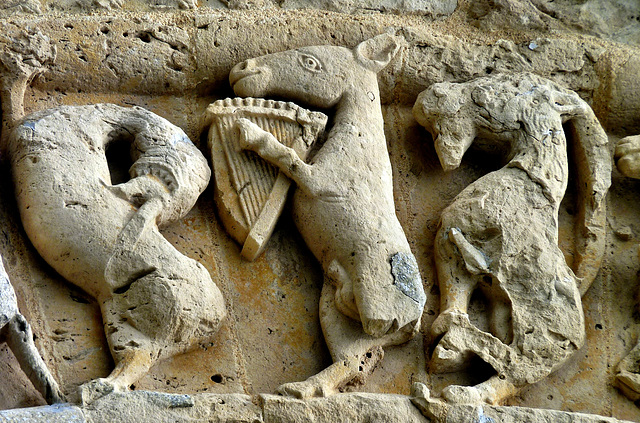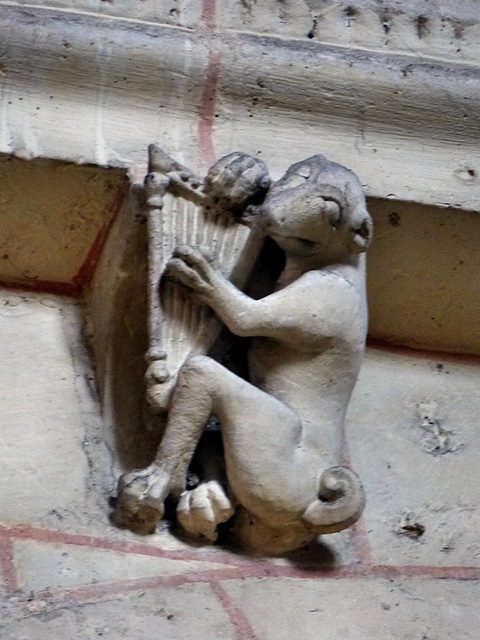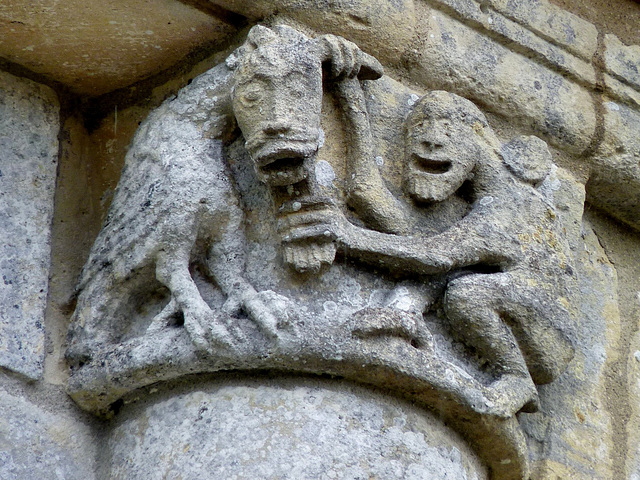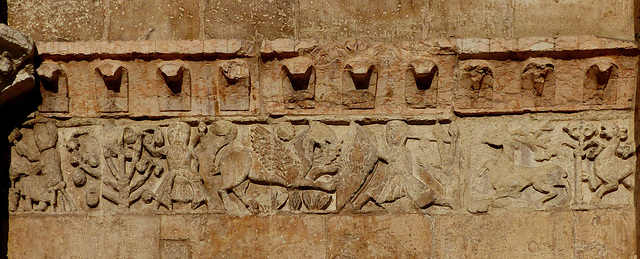
Gifted Animals
Animals had many much more talents in former times. Some worked as musicians.
Aulnay - Saint-Pierre
"Saint-Pierre d'Aulnay" is a church outside of Aulnay, in the center of an old graveyard. The setting has not changed for centuries. For the pilgrims of the 12th century this church was a major halt - and it still is for all the tourists...
A predecessing church „Saint-Pierre-de-la-Tour“ had been here, that, when the pilgrimage to Santiago de Compostella got more and more popular, was obviously to small, as Aulnay was conveniently situated between Poitiers and Saintes on the Via Turonensis. A new, larger church was needed, so the place was handed over to the chapter of the cathedral in Poitiers. The canons then probably planned this church, that was erected from about 1130/1140 on.
"Saint-Pierre d'Aulnay" is a gem of the "style saintongeais". For Peter Strafford ("Romanesque Churches Of France") this is "one of the best examples of late Romanesque architecture in what used to be Aquitaine".
Saint-Pierre´s "South Porch" is what attracts busloads of tourists to stop in Aulnay. And they are right.The "South Porch" is mindblowing.
The most outer archivolt is the most spectacular one. So far the icons were somehow in an expectable "christian tradition" (Elders, Saints), but here mythical beasts and fantastic hybrid creatures come to life. Some of these chimerae probably derive from medieval Bestiary, while others seem to come straight from a drug related nightmare.
The ass playing the harp with the hoof is a theme, that can often be found on medieval churches. It is believed that this icon is a symbol of ignorance. Here is an article on this theme, tracking it back thousends of years:
artsymbol.wordpress.com/category/romanesque-symbolism/
Surgères - Notre-Dame
Notre-Dame de Surgères was erected in the center of a large castle in the 12th century. The fortification, founded in the 9th century as a motte, when the area was raided by the Vikings, then guarded the border of the historical province of Aunis once.
When the church was built a small town had developed around the defence already. Later a small priory and a "hopital" existed, as this was a halt on the Via Turonensis. The pilgrims had a lot to gape here, the facade is stunning 23 meters wide.
Eleanor of Aquitaine married Henry II of England in 1152, so the area changed hands and was ruled by the House of Plantagenet. During the Hundred Years' War Surgères experienced a long period of decline. Louis XI´s troops conquered the town in 1472 and the fortifications got destructed. During that time Notre Dame lost the tower and large parts of the nave, but not the facade!
Six blind arches once flanked the door, five arches above them on "the second floor". There are more than 100 capitals and corbels all over the facade. This seems to be a medieval encyclopedia.
The ape, just seen n the previous upload, is a very gifted, but (judging from his facial expression) not really happy harpist.
Poitiers - Cathedral
On the ruins of a older basilica begann, just next to the Baptistère Saint-Jean the construction of large Cathédrale Saint-Pierre in 1162. The building, the new the seat of the Archbishop of Poitiers, was greatly funded by Henry II of England (aka "Henri II Plantagenêt") and Eleanor of Aquitaine.
The construction started as usual in the east and was completed with the western facade end of the 13th century.
The cathedral is best known for the wonderful stained glass windows. The three windows around the choir date back to the 12th century and may be the oldest in France.
But of course, there are lots of carvings as well. Here is a monkey, playing the harp. That is what I thought, when I took the photo, but meanwhile i know, that the musician is a dog.
Matha - Saint-Pierre de Marestay
There had been a small community of monks here, that end of the 11th century joined the important Benedictian Abbaye royale of Saint-Jean-d'Angély (20kms northwest), that was part of the cluniac network.
The Abbaye royale got wealthy through the thousands of pilgrims on the Via Turonensis. They all stopped to see the relic of John the Baptist, before they continued, and obviously left some coins.
The abbey could afford to build a prestigious abbey church for the monastic comunity in Marestay (now Matha) at the same time, when Saint-Hérie (see previous uploads), just 2kms apart from here, was erected. Probably the same monks, lay brothers and workers toiled on two construction sides in long double shifts.
During the Wars of Religion many curches within the whole area got ruined and mutilated. In Saint-Herie, 2kms south, only two walls of the Romanesque church are still in place. Here the complete nave is missing.
After the "Edict of Nantes" got revoked in 1685, all Huguenots living in Matha were evicted and exiled. Following that all protestant churches existing in the town got leveled to the ground.
The only parts of Saint-Pierre that survived the incredible fury are the apse, the transepts and the crossing.
Many capitals and corbels are still in place and can be found outside.
A bearded person with very long hair kids a kind of harpy (head of a bull). He has grabbed a horn of the bull´s head and holds a pan-flute in front of the the bull´s open mouth. Or is he pulling a beard? Seems, that man has fun in, he is grinning broadly, the bull looks a bit depressed.
Soto de Bureba - San Andrés
San Andrés was erected on a little hill, that was settled already in pre-Roman times, as recent excavation proved. The tiny hamlet Soto de Bureba is part of the village Quintanaélez (pop. ~ 100).
An inscription above the portal gives the construction date of 1175. During medieval times the area must have been much more densely populated, as later even a second nave was added to the structure.
The parish church is known for its wonderful, sculpted portal, seen here. The arches have an interesting, but somehow strange iconography. Some of the icons are pretty unique. There is a collection of really fantastic and mythical beasts.
In the center is a legendary, horse like animal, that was so rarely seen, that even educated people, who could read and write, could not recognize it without a hint. So it got an inscription, that reads UNICORNIUM.
Though the unicorn here wears a long beard, the horn is pretty short.
Verona - Duomo di Verona
The first cathedral here was consecrated by St. Zeno around 380 AD. This was replaced by a larger building already two centuries later. An earthquake and/or fire destroyed that structure. The basilica that got rebuilt was destroyed by the earthquake in 1117, that wrecked so many buildings in Veneto and Lombardy.
The present "Cattedrale Santa Maria Matricolare" was built in 1117-38, but many renovations were made later.
The two storied porch, of the cathedral´s façade, is embellished with sculptures, works of the sculptor Nicholaus (Niccolo), who as well worked at San Zeno in Verona, in Ferrara and Piacenza.
Lots of interesting details can be found on the façade, many around music and hunting. Here is a weathered frieze. From left: a cobbler or a cooper (?), a bearded man picking fruits, a fight between a winged dragon and a warrior, a deer and another animal. But not a kangaroo.
Milan - Basilica of Sant'Ambrogio
Milan is the city capital of the Lombardy and the second most populous city in Italy after Rome. Known during Roman times as "Mediolanum" it was the place, where in 313 Constantine I and Licinius met and "signed" the "Edict of Milan", giving Christianity a legal status within the Roman empire.
At the end of the Roman empire Milan was besieged by the Visigoths in 402, looted by the Huns in 452, and taken by the Ostrogoths in 539. Only 30 years later is belonged to the Kingdom of the Lombards, until in 774 Charlemagne defeated the Langobards and added Milan to the Carolingian empire. During Barbarossa´s (Frederik I) "Italian Campaigns" Milan was taken and destroyed to a great extent.
The "Basilica of Sant'Ambrogio" is much older and was not destroyed by Barbarossa´s troops. It is one of the most ancient churches in Milan, built by St. Ambrose in 379–386, outside the city of Milan on the site of a cemetery, where the martyrs of the Roman persecutions had been buried. The first name of the church was "Basilica Martyrum".
Ambrose, born into a noble family about 340 in (present-day) Trier (Germany), was governor of Liguria and Emilia for two years before he became the Bishop of Milan in 374 by popular acclamation. He was a staunch opponent of Arianism.
Only very few traces of the first church can still be found, as in the centuries after its construction, the basilica underwent numerous restorations and reconstructions. The current Romanesque church, mostly built in brickwork, was begun around 1080.
In 789, a Benedictine monastery was established here. The canons of the basilica, however, retained their own community. So two separate communities shared the basilica. In the 11th century, the canons adopted orders and became Canons Regular. From then on two separate monastic orders following different rules lived in the basilica. The canons were in the northern building, the cloister of the canons, while the monks were in the two southern buildings.
The two towers symbolize the division in the basilica. The 9th century Torre dei Monaci ("Tower of the Monks") tower was used by the monks. However, the canons did not have a bell tower and were not allowed to ring bells until they finished the Canons' bell tower in the 12th Century. This tower got two additional levels in 1889.
In 1943 the basilica got severely damaged by bombings. It took a decade to rebuilt and reconstruct the church.
The ambo stands on the left side of the nave. From here the monks and canons read the Gospel. The ambo, supported by nine slender ancient columns, was built over a 4th century sarcophagus, known as "Stilicho's Sepulchre", between 1130 and 1143. When the roof of the basilica collapsed in 1196, the ambo got severely damaged, but it got rebuilt already in 1201.
There are so many details all around the ambo..
A donkey playing harp is a very common icon in France (standing for foolishness/idiocy). Above the donkey is a griffin biting a dog biting a deer, while on the right a fightened hare watches the scene. In the triangle above a man fights a lion.
Poitiers - Sainte-Radegonde
Radegonde (aka "Radegund", "Radegundis") was a princess, born in Thuringia around 520. She was married to Chlothar I but left her husband and founded the convent "Sainte-Marie-Hors-les-Murs" in Poitiers around 552. The nunnery was the first and became the most important in the Frankish Empire. After having received a fragment of the "True Cross" from the Byzantine Emperor Justinian I, the name of the abbey changed to "Abbaye Sainte-Croix". In 587 Radegonde was buried here. The first church was erected over her tomb.
Radegonde´s remains were exhumed in 1012 for public veneration, what triggered a major pilgrimage to Poitiers. After a major fire, the church was rebuilt. The church of today, constructed from the 11th to 12th centuries, was built in a combination of Romanesque and Gothic styles.
Sculptured corbels line both sides of the nave. A harp playing donkey can often be found in and around Romanesque churches, a very common icon.
Saint-Restitut - Saint-Restitut
The oldest part of the parish church is a funerary tower (Tour Funéraire). It is difficult to date the tower, as the tower got obviously renovated and reconstructed before the Romanesque church was added within the 12th century. Most scholars date the tower to the early 11th century, but archaeologists talk about a building here existing already within the 4th/5th century.
Anyway - here was the tomb of Saint Restitut, patron saint for people having poor eyesight and even Louis XI (aka "Louis the Prudent", "Universal Spider") once came on pilgrimage Saint-Restitut.
The legend tells, that in his younger days Saint Restitut´s name was Sidonius. He was blind...
John 9:1-7
"As he went along, he saw a man blind from birth. (...........)
After saying this, he spit on the ground, made some mud with the saliva, and put it on the man’s eyes. “Go,” he told him, “wash in the Pool of Siloam”. So the man went and washed, and came home seeing."
The name was changed to Restitutus then. He became a disciple of Jesus and later left the Holy Land with the Thee Marys, Lazaraus et al. on the boat with "neither sail nor rudder." They all reached Saintes Maries de la Mer, where the group split. Restitutus walked up the valley of the Rhone to become the first bishop of Tricastin. He resided in St-Paul-Trois-Châteaux - and got buried here.
The nave of the church, added to the tower in the 12th century. One wall of the tower is now part of the church, so the frieze here, that runs all around it, is much better conserved here, than outside (see previous uploads).
Here is an ass playing the harp, a pig or dog juggling - and a palm tree.
Jump to top
RSS feed- Latest items - Subscribe to the latest items added to this album
- ipernity © 2007-2025
- Help & Contact
|
Club news
|
About ipernity
|
History |
ipernity Club & Prices |
Guide of good conduct
Donate | Group guidelines | Privacy policy | Terms of use | Statutes | In memoria -
Facebook
Twitter










